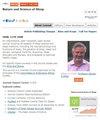与睡眠相关的面下颌肌阵挛患者的咬舌事件:一项病例系列研究
IF 3
2区 医学
Q2 CLINICAL NEUROLOGY
引用次数: 0
摘要
背景:与睡眠相关的面下颌肌阵挛(SRFMM)在临床上仍然罕见。本研究旨在全面了解 SRFMM 的电临床方式、治疗方案和预后:方法:纳入 23 例通过临床表现、视频脑电图(EEG)和双侧咀嚼肌和颞肌肌电图诊断为 SRFMM 的患者。记录并分析了临床和电生理评估以及随访信息:结果:队列中有 4 名婴儿和 19 名成人,SRFMM 的平均发病年龄为 43.5 岁,其中 19 人为男性。21名患者主诉舌头受伤和夜间睡眠不安。4名患者的SRFMM归因于口服阿立哌唑、脑干缺血和脑外伤。在62次SRFMM发作中,93.5%发生在NREM睡眠中,6.5%发生在REM睡眠中,所有事件均与脑电图唤醒有关。在服用或不服用氯硝西泮的13名患者中,运动事件逐渐消失,其余的则是偶发性的:结论:SRFMM 是一种特征性的寄生虫性失眠症,表现为咬舌和伴有面部下颌肌阵挛,导致睡眠中断。除成人外,婴儿也会出现 SRFMM,但会自发缓解。大多数患者对氯硝西泮反应良好,最终预后良好。本文章由计算机程序翻译,如有差异,请以英文原文为准。
Tongue Biting Event in Patients with Sleep-Related Facial Mandibular Myoclonus: A Case Series Study
Background: Sleep-related facial mandibular myoclonus (SRFMM) remains rare in clinical practice. The aim of this study was to provide a comprehensive understanding of the electroclinical manner, therapeutic regimen, and prognosis of SRFMM.
Methods: Twenty-three patients who were diagnosed with SRFMM by clinical manifestation, video-electroencephalography (EEG) and electromyography over bilateral masseter and temporalis muscles were enrolled. Clinical and electrophysiological evaluation as well as follow-up information were recorded and analyzed.
Results: The cohort involved 4 infants and 19 adults with a mean onset age of 43.5 years for SRFMM, among whom 19 were male. Twenty-one patients complained of tongue injuries and disturbed night-time sleep. SRFMM in 4 patients were ascribed to oral aripiprazole, brainstem ischemia and brain trauma. In 62 SRFMM episodes, 93.5% occurred in NREM sleep and 6.5% in REM sleep, and all events were associated with EEG arousals. In 13 patients with or without clonazepam, the motor events gradually disappeared, and the rest turned to be sporadic.
Conclusion: SRFMM is a characteristic parasomnia manifested by tongue biting and accompanying facial mandibular myoclonus, leading to disrupted sleep. Besides adults, infants can also experience SRFMM with spontaneous remission. Most patients respond well to clonazepam, eventually with favorable prognosis.
Methods: Twenty-three patients who were diagnosed with SRFMM by clinical manifestation, video-electroencephalography (EEG) and electromyography over bilateral masseter and temporalis muscles were enrolled. Clinical and electrophysiological evaluation as well as follow-up information were recorded and analyzed.
Results: The cohort involved 4 infants and 19 adults with a mean onset age of 43.5 years for SRFMM, among whom 19 were male. Twenty-one patients complained of tongue injuries and disturbed night-time sleep. SRFMM in 4 patients were ascribed to oral aripiprazole, brainstem ischemia and brain trauma. In 62 SRFMM episodes, 93.5% occurred in NREM sleep and 6.5% in REM sleep, and all events were associated with EEG arousals. In 13 patients with or without clonazepam, the motor events gradually disappeared, and the rest turned to be sporadic.
Conclusion: SRFMM is a characteristic parasomnia manifested by tongue biting and accompanying facial mandibular myoclonus, leading to disrupted sleep. Besides adults, infants can also experience SRFMM with spontaneous remission. Most patients respond well to clonazepam, eventually with favorable prognosis.
求助全文
通过发布文献求助,成功后即可免费获取论文全文。
去求助
来源期刊

Nature and Science of Sleep
Neuroscience-Behavioral Neuroscience
CiteScore
5.70
自引率
5.90%
发文量
245
审稿时长
16 weeks
期刊介绍:
Nature and Science of Sleep is an international, peer-reviewed, open access journal covering all aspects of sleep science and sleep medicine, including the neurophysiology and functions of sleep, the genetics of sleep, sleep and society, biological rhythms, dreaming, sleep disorders and therapy, and strategies to optimize healthy sleep.
Specific topics covered in the journal include:
The functions of sleep in humans and other animals
Physiological and neurophysiological changes with sleep
The genetics of sleep and sleep differences
The neurotransmitters, receptors and pathways involved in controlling both sleep and wakefulness
Behavioral and pharmacological interventions aimed at improving sleep, and improving wakefulness
Sleep changes with development and with age
Sleep and reproduction (e.g., changes across the menstrual cycle, with pregnancy and menopause)
The science and nature of dreams
Sleep disorders
Impact of sleep and sleep disorders on health, daytime function and quality of life
Sleep problems secondary to clinical disorders
Interaction of society with sleep (e.g., consequences of shift work, occupational health, public health)
The microbiome and sleep
Chronotherapy
Impact of circadian rhythms on sleep, physiology, cognition and health
Mechanisms controlling circadian rhythms, centrally and peripherally
Impact of circadian rhythm disruptions (including night shift work, jet lag and social jet lag) on sleep, physiology, cognition and health
Behavioral and pharmacological interventions aimed at reducing adverse effects of circadian-related sleep disruption
Assessment of technologies and biomarkers for measuring sleep and/or circadian rhythms
Epigenetic markers of sleep or circadian disruption.
 求助内容:
求助内容: 应助结果提醒方式:
应助结果提醒方式:


